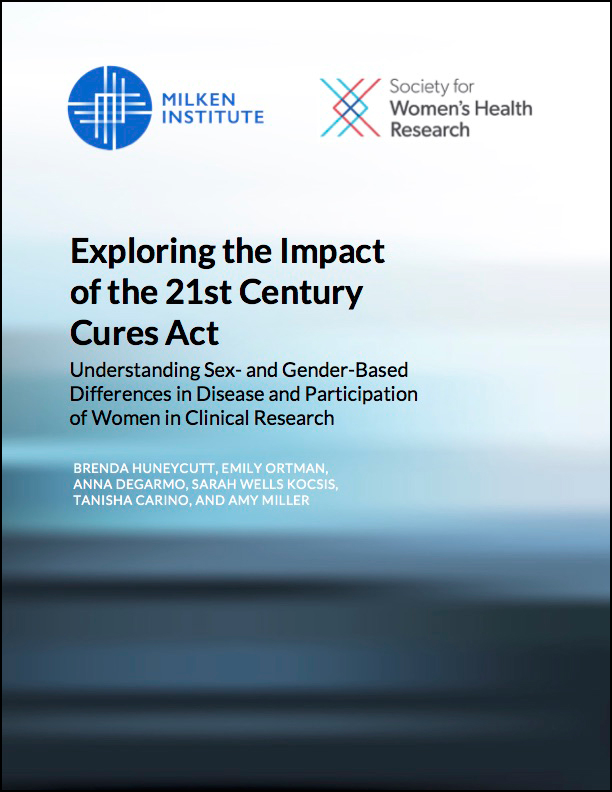By Emily Ortman, SWHR Communications Director
 The Society for Women’s Health Research and FasterCures, a center of the Milken Institute, released a report today outlining the positive changes for women’s health research from the 21st Century Cures Act. The report, “Exploring the Impact of the 21st Century Cures Act,” details how the Cures Act, signed into law on December 13, 2016, has affected the landscape for women in clinical research and the understanding of sex- and gender-based differences in disease.
The Society for Women’s Health Research and FasterCures, a center of the Milken Institute, released a report today outlining the positive changes for women’s health research from the 21st Century Cures Act. The report, “Exploring the Impact of the 21st Century Cures Act,” details how the Cures Act, signed into law on December 13, 2016, has affected the landscape for women in clinical research and the understanding of sex- and gender-based differences in disease.
Bolstering Inclusion of Sex as a Biological Variable in Research
Most of what is known about basic biology stems from research on male cells, animals, and disease models. Because of this historical bias, researchers missed the opportunity to identify potential sex and gender differences in disease, resulting in knowledge gaps that put the health of women at risk.
To address this issue, the National Institutes of Health (NIH) implemented a policy in January 2016 that required NIH-funded researchers to consider sex as a biological variable (SABV) in their preclinical research designs, analyses, and reporting. The SWHR-FasterCures report describes how the Cures Act bolstered NIH efforts around SABV.
The Cures Act directed NIH to ensure researchers are complying with the 2016 policy and instructed the agency to develop new policies for basic research projects to assess biological variables (including sex) and how differences between male and female cells, tissues, or animals may be examined and analyzed.
In addition, the Cures Act tasked NIH with forming a working group to develop recommendations to increase rigor and transparency in research, including consideration of SABV in preclinical experiment design. NIH is now implementing these changes to its grant application and increasing training for researchers on SABV.
“Scientific culture will change to serve women’s health better as more researchers report the sex of the cells, tissues, and animal models they use, consider SABV in study design, and conduct and report the results of sex-based analyses,” according to the report by SWHR and FasterCures.
Increasing Transparency in Clinical Research Reporting and Analysis
The SWHR-FasterCures report also outlines how the Cures Act has helped NIH better track women’s inclusion in research as well as ensure appropriate analysis and dissemination of the research results.
The Cures Act required NIH to publicly disclose the number of women in NIH-funded clinical trials by disease or condition. To do this, NIH created a new Inclusion Statistics Report webpage, which shows the percentage of female participants in trials for 269 diseases and conditions.
NIH noted that making this inclusion data available will help increase “understanding of the distribution of participants in our research to ensure the knowledge gained from NIH research is applicable to those populations with the condition or disease under study.”
The Cures Act further directed NIH to ensure that the results of sex and gender analyses in applicable NIH-funded clinical trials are submitted to ClinicalTrials.gov.
“Advancing research and health care requires action and transparency. If sex-based analyses are not conducted and reported, we cannot learn from them,” SWHR and FasterCures note in the report.
Accelerating Research on Pregnant and Lactating Women
According to the SWHR-FasterCures report, the Cures Act also brought much-needed attention to the lack of research on pregnant and lactating women by establishing the Task Force on Research Specific to Pregnant Women and Lactating Women (PRGLAC).
After a series of public meetings, the PRGLAC task force submitted a report to the Secretary of Health and Human Services (HHS) and Congress with 15 recommendations to improve the development of safe and effective therapies for pregnant and lactating women. Earlier this year, HHS extended the term of the PRGLAC Task Force for 2 additional years to provide advice and guidance on the implementation of its recommendations.
SWHR considers research on pregnant and lactating women as the next frontier for the inclusion of women in medical research, and the report stresses that the continuation of PRGLAC’s work is essential to addressing this research gap.
Future Opportunities to Advance Women’s Health Research
In the report, SWHR and FasterCures conclude that the Cures Act “has advanced the field of women’s health in significant ways and has emphasized the critical importance of women’s participation in clinical trials and the study and reporting of sex- and gender-based differences in disease.”
As Congress considers crafting a second iteration of the Cures Act, SWHR encourages policymakers to create incentives that encourage financial investment in women’s health research across public and private sectors.
Moving forward, the report encourages making the study of SABV a priority in federally funded research and expanding initiatives such as the NIH’s Sex & Gender Administrative Supplement Program, which grants supplemental funding as an incentive to add a sex component to an existing research program.
To improve the health of women across the lifespan, the report calls for optimizing the identification of research, conditions, and disease categories that warrant more attention and encouraging open dialogue within the scientific community to advance biomedical research and accelerate innovation.
